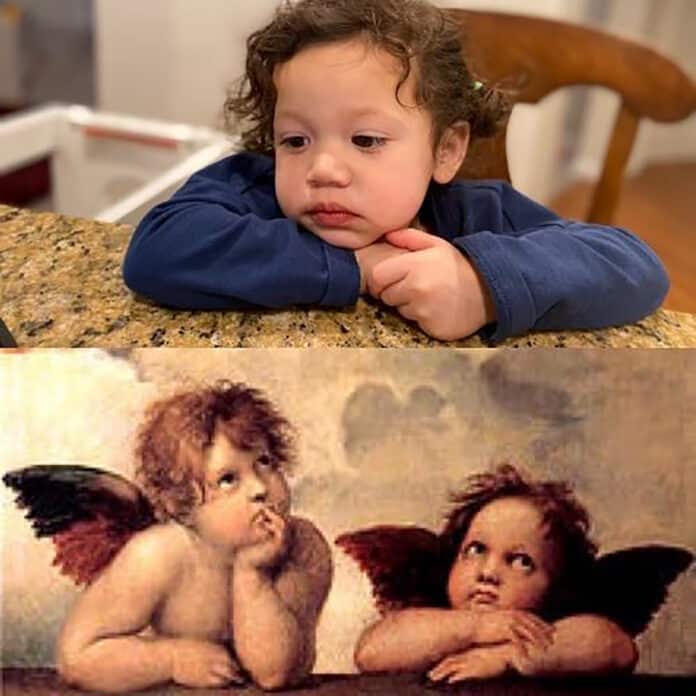He was stretched out on my left, turned toward me as he rested on his side, breathing quietly in blissful, contented sleep. As I lay enjoying the beauty of the man’s peacefulness, up popped a bevy of plump little naked bodies with rounded bottoms, their soft shoulders adorned with tiny wings. Gleefully they frolicked up and down and over this man as though the terrain of his body was their playground. I reached out to shake him into waking and tell him what was happening. Just then…
I awoke. There lay my husband sleeping as peacefully as in my dream. The tiny, chubby, winged children were nowhere to be seen when the phone alarm played softly and he opened his eyes. We embraced and said our “good mornings”.
Over the coffee David brought upstairs and back to bed, I told him of my pleasantly curious dreaming of the little people playing on him. Online we looked up images of the cherubic figures familiar in art and known as putti. Some were frolicking like I saw them in the night. One familiar twosome, painted long ago by Raphael, was resting and appeared to be thinking their most angelic thoughts.
As amused as I to begin our day in the company of baby angels, David went back downstairs to make our breakfast. I began moving into the opening asana of my morning yoga, when “ping” went my phone announcing an artful message sent by our east coast daughter.
Sitting down on the edge of the bed, lost in a reverie of deja vue, I stared at my little screen, seeing Audrey’s two images stacked one atop the other. The one above was of our two-year-old granddaughter, whom of course we think of as cherubic. Her sweet, chubby-cheeked face was lost in thought, haloed in dark ringlets and resting on her crossed arms propped on the kitchen counter. Alexandra looked just as pensive as the two cherubs who appeared below her in Raphael’s classic, well-known painting that David and I had just seen only moments earlier in our internet browsing inspired by my dream.
Dreams can be curious messengers. What am I to make of mine? My dream? My early morning messengers? What were those putti up to cavorting over my husband? Were they merely playfully getting my attention—pre-telling me of the phone text and pictures I was about to receive?
Putti, in the ancient classical world of art, were winged infants that were believed to influence human lives. Derived from personifications of love in Greek and Roman art, putti, cupids and angels can be found in both religious and secular art from the 1420s in Italy. Putti were portrayed in Italian paintings, especially those of the Madonna and Child. They later appeared in the Netherlands, Germany and France. Today’s putti are mostly seen as bow and arrow toting cupids acting as the harbingers and facilitators of Valentine love.
The two relaxed putti who appear below Alexandra’s image, though unequipped with bows and arrows, are certainly images of loving adoration painted by Raffaello Sanzio da Urbino (1483-1520), known to us as Raphael. One of the most well-known angel paintings of all time, Raphael’s putti are some of the most beloved and reprinted angels of Western art.
Though most often appearing in isolation, Raphael’s delightful putti pair is taken from a much larger work in oil: the Sistine Madonna or La Madonna di San Sisto, one of Raphael’s last completed works. On the canvas, accompanied by Saint Sixtus and Saint Barbara, the Virgin Mary stands upon a cloud holding the Christ child. The two cherubim are located at the very bottom of the painting. Nearly destroyed by allied bombs dropped on Dresden, Germany, during World War II, Raphael’s painting was saved by Russian forces. Though briefly held by the Soviet Union, the painting returned to Germany and can be seen today in the Gemäldegalerie Alte Meister with the two putti still looking up in adoration.
The message of my dream? Perhaps the putti appeared to remind me that in all times, peaceful and chaotic, too, our precious Alexandra and her sister Sophie, their grandpère and all of us are always in the company of adoring baby angels, if we can only imagine they are with us in our dreams and seek them in the work of artists who imagined them, too.



















